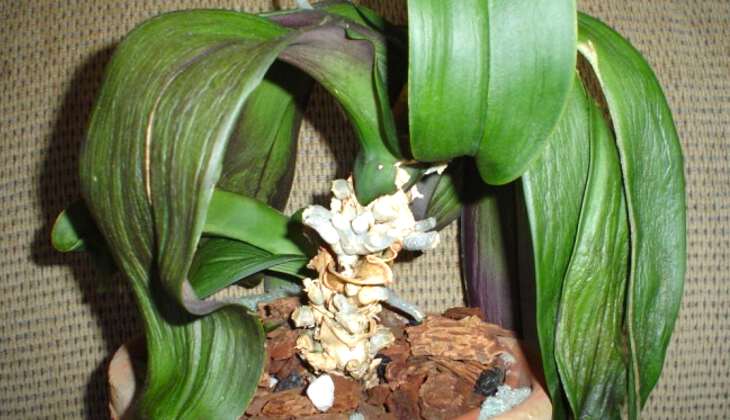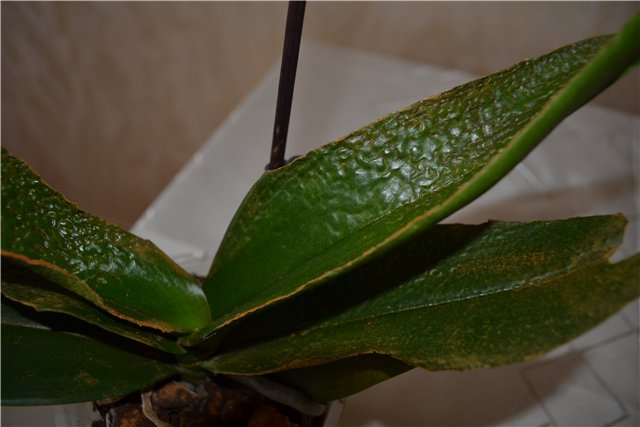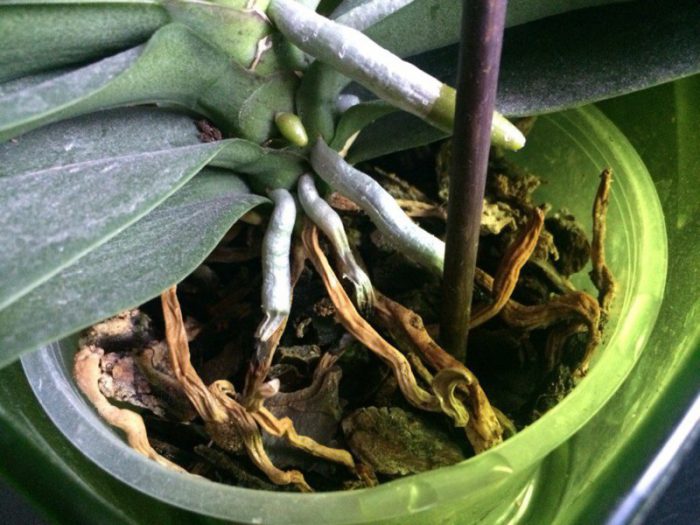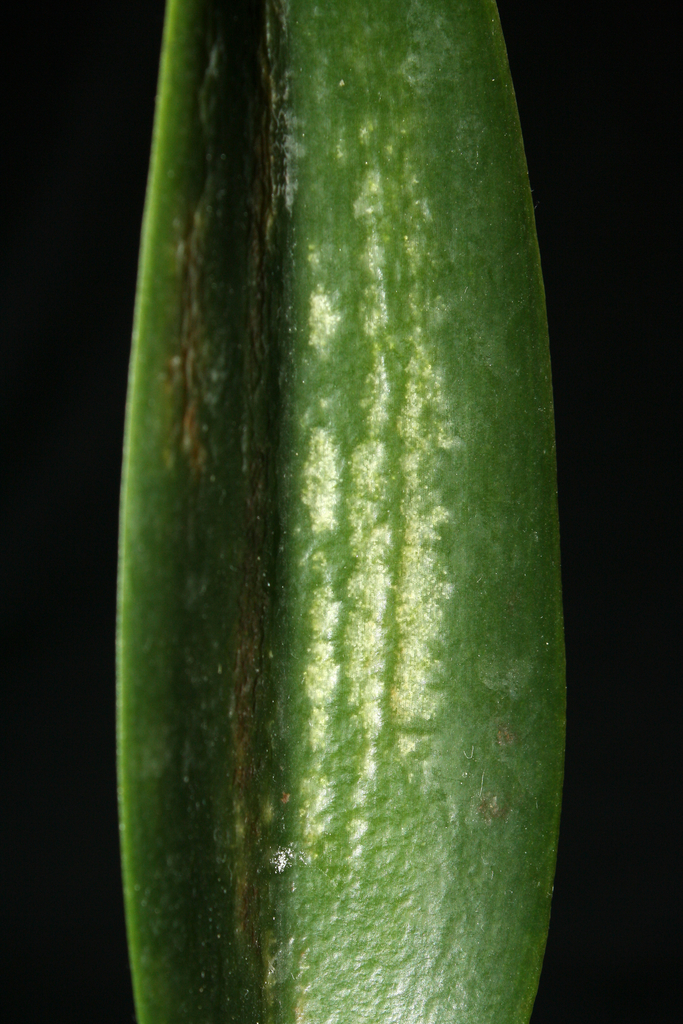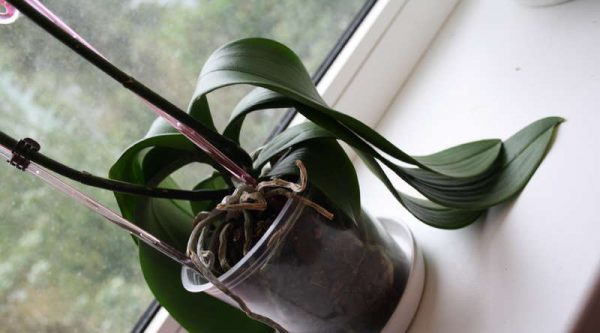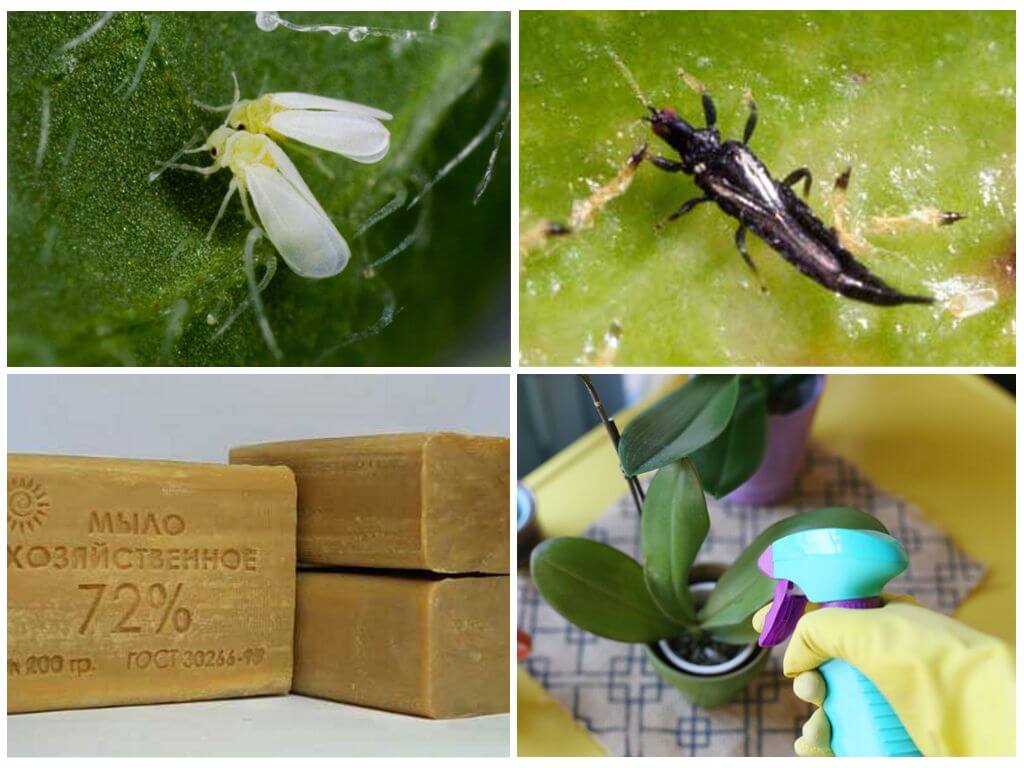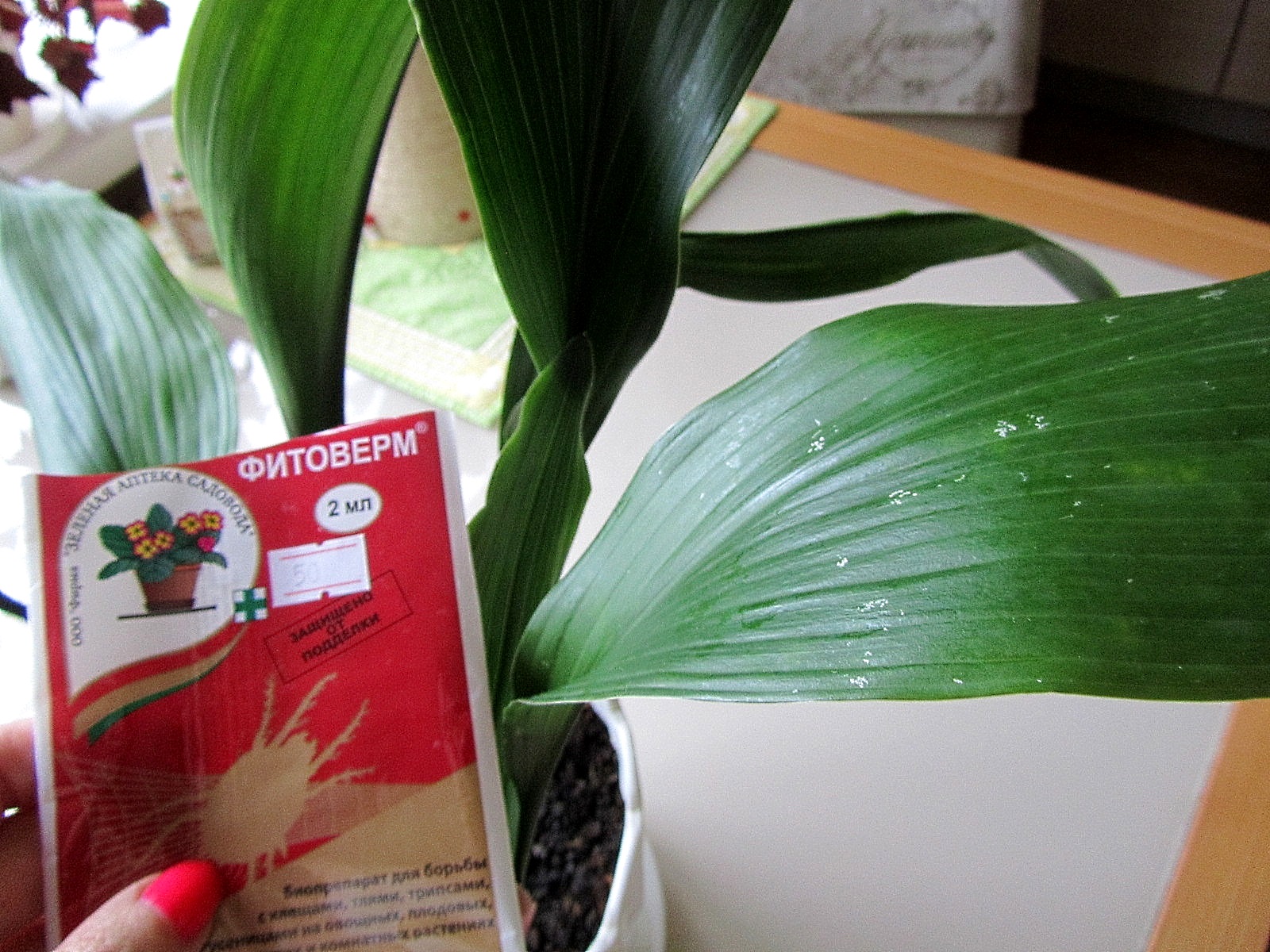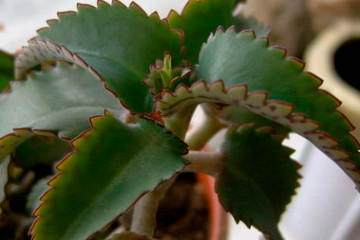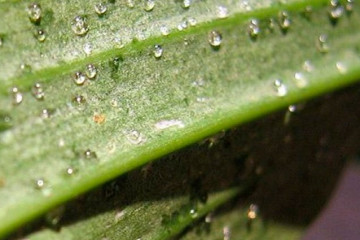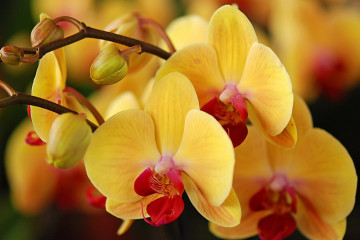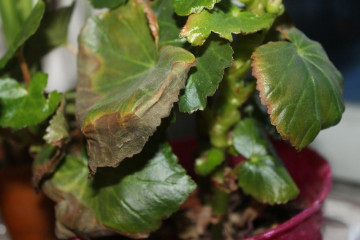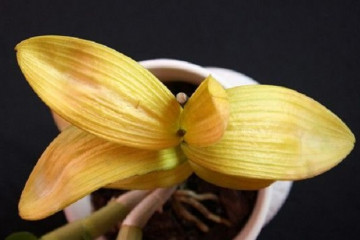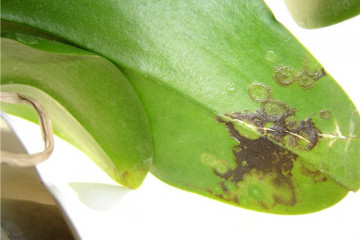Why do orchid leaves wither: causes and methods of dealing with them
Content:
There is not a single other plant on Earth, over which nature has worked so carefully. Orchids are famous not only for their beauty, but also for their variety of unusual shapes. Exotic plants have long been adapted in Russian latitudes and are considered unpretentious. There are still reasons why the leaves of an orchid wither.
The main factors of wilting
The drooping foliage of an orchid is evidence of a lack of nutrients.
Other factors affecting the root system and the aerial part of the plant can also lead to wilting.
Hypothermia
Low temperatures are typical for the winter period. If Phalaenopsis leaves begin to wither, it is recommended to check the temperature near the window. It should not fall below + 15 ° С, otherwise the plate will lose its turgor, and the tropical plant will stop blooming and even disappear.
Overheat
Intense heat is also harmful to orchids. Under the influence of high temperatures, water actively evaporates from the soil, the root system suffers from a moisture deficit. The plant is forced to use its own "reserves", sucking water from the leaves.
Insufficient watering
Indoor flowers experience a lack of moisture with improper irrigation. Some owners water the plants after a certain period of time, regardless of the condition of the soil.
The soil may dry out earlier due to the heat, a certain looseness of the substrate, the size of the pot.
Waterlogging
Orchids love to "drink", but excess moisture is detrimental to the roots - it prevents air from circulating in the soil. If at the same time the substrate is dense, then the underground part becomes vulnerable to diseases, it can rot. As a result, the leaves of the orchid wither.
Excess food
Top dressing is good in moderation. Phalaenopsis is sensitive to an increased concentration of active substances in the soil. Due to an excess of salt, the roots may dry out, the process will switch to the upper part of the plants.
Why leaves wrinkle
The second problem sometimes observed by orchid growers is shriveled leaves. Loss of elasticity is often associated with disruptions in biochemical processes. The reasons described below lead to this.
Root system problem
The main organ that gives strength to the entire plant is the root. If he is uncomfortable, the ground part suffers. Among the reasons provoking leaf turgor are:
- lack of nutrients (in other words, depleted substrate);
- dry soil that does not provide the root with moisture;
- a cramped pot that prevents the system from developing.
If these factors are not eliminated in time, the roots will dry out, the green foliage will begin to turn yellow, fall off, and the orchid will quickly die.
Pests
The exotic plant is weakly resistant to sucking insects (thrips, ticks, scale insects, mealbugs, aphids). The parasites suck the juice out of the leaf, and the plate immediately begins to wrinkle. In addition to the loss of turgor, there is a risk of contracting viral diseases.
Diseases
An orchid can become infected not only from pests. There are other factors that provoke diseases of a tropical plant.
Major diseases of orchids
| Views | The reasons | Signs |
|---|---|---|
| Rot | ||
| Black | Hypothermia, immunity weakened by pests | It affects all parts of the plant. The leaves do not just wrinkle, but acquire a black tint. |
| Brown | Excessive watering and low temperatures | The disease often affects young leaves, manifesting itself as light brown watery spots |
| Fusarium | High humidity, poor air circulation | The leaf plate wrinkles, becomes flabby, covered with pinkish fungal spores |
| Gray | Violation of regimes, improper feeding | Dark islets, pubescent with a gray bloom, affect not only foliage, but also buds and already opened flowers |
| Other diseases | ||
| Spotting | A lot of direct light at the beginning of the growing season, over-feeding, improper watering | Dark wet spots are clearly visible on the leaves that have lost turgor. |
| Anthracnose | High air humidity | Black spots grow on wrinkled leaves and pseudobulbs, after which dents appear |
| Powdery mildew | Greenhouse effect (high humidity at high temperatures) | White bloom is visible on the leaves and buds. Damaged areas of the orchid begin to dry, and the flower dies |
Viral diseases introduced to Phalaenopsis by pests appear on wrinkled leaves in round spots.
You can see other "arts" of mosaic spotting: arrows and stripes.
Transplants
When moving the orchid from one container to another, the plant will be lethargic during the first days. If after 5 days the wrinkling on the leaves has not passed, and the turgor continues to fall, the transplant was performed without observing the requirements of agricultural technology:
- the substrate is incorrectly selected;
- the acid-base balance is disturbed;
- there is no drainage hole in the container (for example, a glass drinker is used instead of a pot).
Why leaves are soft and wrinkled
If the leaves of an orchid are soft and sluggish, reasons should be sought both in violation of regimes and in diseases. Correct identification of harmful factors will help save a houseplant.
Overheat
Tropical cultures have learned to endure the heat. Prolonged exposure to high temperatures leads to overheating of the plant, and it actively evaporates moisture. The substrate also undergoes this process.
Roots suffer from thirst, becoming lethargic. They are unable to support the ground part, and the foliage sags quickly.
Root diseases
A common reason why the soft leaves of an orchid wrinkle are problems with the root system. To make sure of this, you need to stir the weakened plant. If the roots are sore, the flower will easily give in to movement.
When removing the plant from the pot and examining its underground part, you can see brown spots, indicating rotting of the roots (in a healthy orchid, they are light green). The lower leaves are also affected, which first soften, then die off.
Lack of moisture
Orchids are epiphytic plants and endure the lack of watering, being content with their own reserves. Sometimes foliar irrigation is enough for them. If the substrate is not wetted for a long time, it becomes denser, and the roots are trapped in a "stone dungeon". Having become exhausted, the system will not be able to supply food to other parts of the plant. This immediately leads to leaf lethargy.
Bad water
In caring for an orchid, not only the frequency of watering is important, but also the quality of the liquid used for this. Tap water is not suitable here - it is too salty with impurities. They gradually accumulate in the substrate, clogging it with toxins.
Orchid treatments
If sluggish leaves are found on an orchid, you need to immediately identify the cause of the problem in order to take the right measures. In mild cases, folk remedies are suitable for treatment. In a neglected situation, it is worth turning to more serious drugs.
Traditional methods of treatment
Not all problems leading to wilting of orchids can be eliminated with improvised means. Homemade recipes will cope with some diseases at the initial stage.
Traditional therapy for diseases
| Means | How to cook | How to apply |
|---|---|---|
| Soda ash solution | · Water (5 l) is brought to a boil; · Dissolve soda (25 g); · Add liquid soap (5 g); Allow to cool to room temperature | With a break of a week, the plant and the topsoil are treated 2-3 times per season |
| Potassium permanganate | Permanganate (2.5 g) is diluted in water (10 l) | Spray the orchid a couple of times with a break of 5 days |
| Baking soda | Soda (1 tbsp) is mixed with liquid soap (0.5 tsp); Diluted with water (4 l) | The plant is sprayed 3 times at weekly intervals. |
| Ash | · Water (10 l) is heated to 35 °; · Pour ash (1 kg); · Insist 5-7 days; · Filter; Add a little soap (liquid) | The solution is used to treat the orchid for 3 days in a row |
| Sugar syrup | Dissolve 4 tsp in a glass of water. Sahara | In the evening, the solution is applied to the lower plate of a sluggish leaf using a wide watercolor brush. In the morning, the sweet bloom must be washed off so that the plant can breathe. |
To effectively control pests, you will have to take into account the type of insect. In each case, the orchid is washed under running water, manually removing parasites from it. In this case, you can use soap solutions.
Folk remedies for pests
| Insect | Control measures |
|---|---|
| Shields | It is recommended to wipe the damaged areas with ethyl alcohol, olive oil, garlic juice |
| Aphid | The infusion of onion husks or citrus peels helps a lot |
| Scorms | You can add denatured alcohol or olive oil to soap compositions |
| Spider mite | An infused decoction of cyclamen tubers helps well, which need to process the orchid several times, maintaining an interval of 5 days |
| Thrips | A garlic or onion solution (1 teaspoon of gruel per glass of liquid), as well as olive oil diluted with water (2 tablespoons per 1 liter) |
Chemicals
If the flower is affected by rot, use fungicides (HOM, Kuprazol, Fundazol, copper sulfate), spraying the diseased plant 3 times with an interval of 10 days. For bacterial diseases, Gentamicin, Furacilin, Streptocid are used.
As for insects, here they select systemic pesticides that affect the food and nervous systems.
Insecticides
| Insect | Drugs |
| Shields | After manual removal of parasites, the plant is treated with Fitoverm or Aktellik, repeating the procedure after a week |
| Aphid | After a shower, the flower is treated with Chlorophos or Fitoverm |
| Scorms | Twice with an interval of a week, spray the lower part of the plant and the substrate |
| Thrips | After removing the damaged areas, the flower is irrigated with Aktellik or Fitoverm. After 10 days, the procedure is repeated. |
In order not to harm the plant, it is necessary to use pesticides strictly according to the instructions attached to the preparation.
Further care of the orchid
Trying to revive a sluggish flower, you should not expect a quick result. To recover, the orchid will need at least 3 days. Proper plant care is important here:
- first of all, they establish all modes: thermal, light, irrigation;
- maintain optimal air humidity within 60-70%;
- 10 days after treatment, feeding is resumed, which should be moderate;
- Once a month, the orchid is bathed under running water;
- every 30 days, the sheets are sprayed with copper sulfate;
- moisture trapped in the core of the pseudobulbs and sinuses is immediately removed with a dry clean cloth;
- regularly ventilate the room, ensuring sufficient air circulation around the leaves of Phalaenopsis.
If the problem has affected the root system, it is better to transplant the plant into another pot, which is heat sterilized. The new substrate is also disinfected. Transplanting will slow down flowering but prevent the plant from withering completely.
